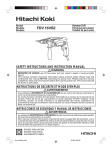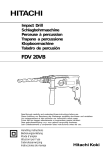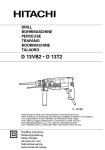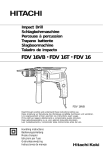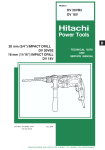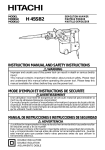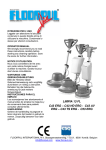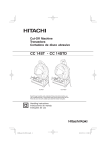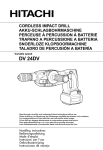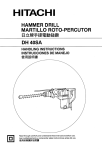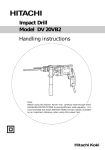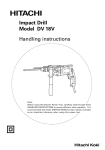Download InFocus FDV 16VB2 User's Manual
Transcript
Impact Drill Taladro de percusión FDV 16VB2 Handling instructions Instrucciones de manejo Read through carefully and understand these instructions before use. Leer cuidadosamente y comprender estas instrucciones antes del uso. 1 2 3 2 1 4 5 1 2 4 3 4 3 4 9 L 7 6 8R 5 A 6 E B D 0 1 C 1 2 3 4 5 6 7 8 9 0 A B C D E 2 Engilsh Ring Sleeve Tighten Loosen Side handle Chuck wrench Push button R mark L mark Impact Rotation Speed control dial High speed Low speed Stopper Español Anillo Manguito Apretar Aflojar Asa lateral Llave Botón pulsador Marca R Marca L Impacto Rotación Dial de control de velocidad Alta velocidad Baja velocidad Tope R L English GENERAL OPERATIONAL PRECAUTIONS WARNING! When using electric tools, basic safety precautions should always be followed to reduce the risk of fire, electric shock and personal injury, including the following. Read all these instructions before operating this product and save these instructions. For safe operations: 1. Keep work area clean. Cluttered areas and benches invite injuries. 2. Consider work area environment. Do not expose power tools to rain. Do not use power tools in damp or wet locations. Keep work area well lit. Do not use power tools where there is risk to cause fire or explosion. 3. Guard against electric shock. Avoid body contact with earthed or grounded surfaces. (e.g. pipes, radiators, ranges, refrigerators). 4. Keep children and infirm persons away. Do not let visitors touch the tool or extension cord. All visitors should be kept away from work area. 5. Store idle tools. When not in use, tools should be stored in a dry, high or locked up place, out of reach of children and infirm persons. 6. Do not force the tool. It will do the job better and safer at the rate for which it was intended. 7. Use the right tool. Do not force small tools or attachments to do the job of a heavy duty tool. Do not use tools for purposes not intended; for example, do not use circular saw to cut tree limbs or logs. 8. Dress properly. Do not wear loose clothing or jewelry, they can be caught in moving parts. Rubber gloves and non-skid footwear are recommended when working outdoors. Wear protecting hair covering to contain long hair. 9. Use eye protection. Also use face or dust mask if the cutting operation is dusty. 10. Connect dust extraction equipment. If devices are provided for the connection of dust extraction and collection facilities ensure these are connected and properly used. 11. Do not abuse the cord. Never carry the tool by the cord or yank it to disconnect it from the receptacle. Keep the cord away from heat, oil and sharp edges. 12. Secure work. Use clamps or a vise to hold the work. It is safer than using your hand and it frees both hands to operate tool. 13. Do not overreach. Keep proper footing and balance at all times. 14. Maintain tools with care. Keep cutting tools sharp and clean for better and safer performance. Follow instructions for lubrication and changing accessories. Inspect tool cords periodically and if damaged, have it repaired by authorized service center. Inspect extension cords periodically and replace, if damaged. Keep handles dry, clean, and free from oil and grease. 15. Disconnect tools. When not in use, before servicing, and when changing accessories such as blades, bits and cutters. 16. Remove adjusting keys and wrenches. Form the habit of checking to see that keys and adjusting 17. 18. 19. 20. 21. 22. wrenches are removed from the tool before turning it on. Avoid unintentional starting. Do not carry a plugged-in tool with a finger on the switch. Ensure switch is off when plugging in. Use outdoor extension leads. When tool is used outdoors, use only extension cords intended for outdoor use. Stay alert. Watch what you are doing. Use common sense. Do not operate tool when you are tired. Check damaged parts. Before further use of the tool, a guard or other part that is damaged should be carefully checked to determine that it will operate properly and perform its intended function. Check for alignment of moving parts, free running of moving parts, breakage of parts, mounting and any other conditions that may affect its operation. A guard or other part that is damaged should be properly repaired or replaced by an authorized service center unless otherwise indicated in this handling instructions. Have defective switches replaced by an authorized service center. Do not use the tool if the switch does not turn it on and off. Warning The use of any accessory or attachment, other than those recommended in this handling instructions, may present a risk of personal injury. Have your tool repaired by a qualified person. This electric tool is in accordance with the relevant safety requirements. Repairs should only be carried out by qualified persons using original spare parts. Otherwise this may result in considerable danger to the user. 3 English SPECIFICATIONS Voltage (by areas)* Power input No load speed Steel Capacity Concrete Wood Weight (without cord) (110V, 115V, 120V, 127V, 220V, 230V, 240V) 550W* 0–2900/min 13 mm 16 mm 25 mm 1.6 kg *Be sure to check the nameplate on product as it is subject to change by areas. STANDARD ACCESSORIES For entire area (1) Side handle ............................................................... 1 (2) Depth stopper ........................................................... 1 For partial areas (1) Chuck wrench ............................................................ 1 (For drill chuck with chuck wrench) (2) Plastic case ................................................................ 1 Standard accessories are subject to change without notice. APPLICATIONS 䡬 By combined actions of ROTATION and IMPACT: Boring holes in concrete, marble, granite, tile, and similar materials. 䡬 By ROTATIONAL action: Boring holes in metal, wood and plastic. Tightening wood screws. chuck, firmly grasp the ring and tighten the sleeve by turning it toward the right (in the clockwise direction as viewed from the front). (See Fig. 1) 䡬 If the sleeve becomes loose during operation, tighten it further. The tightening force becomes stronger when the sleeve is tightened. (2) Dismounting the bit Firmly grasp the ring and loosen the sleeve by turning it toward the left (in the counterclockwise direction as viewed from the front). (See Fig. 1) NOTE When the sleeve does not become loose any further, fix the side handle to the sleeve. Then, strike the grip of the side handle to the left in order to loosen the sleeve,while holding the ring by hand. (Fig. 2) CAUTION Do not fix the side handle to the ring of the keyless chuck because of a risk that doing so may damage the ring. For Drill chuck with chuck wrench PRIOR TO OPERATION 1. Power source Ensure that the power source to be utilized conforms to the power requirements specified on the product nameplate. 2. Power switch Ensure that the power switch is in the OFF position. If the plug is connected to a receptacle while the power switch is in the ON position, the power tool will start operating immediately, inviting serious accident. 3. Extension cord When the work area is removed from the power source. Use an extension cord of sufficient thickness and rated capacity. The extension cord should be kept as short as practicable. 4. Fixing the side handle Attach the side handle to the mounting part. Rotate the side handle grip in a clockwise direction to secure it. Set the side handle to a position that is suited to the operation and then securely tighten the side handle grip. 5. Mounting and dismounting of the bit. For keyless chuck (1) Mounting the bit After inserting a driver bit, etc. into the keyless drill 4 6. 䡬 䡬 䡬 7. 8. Fit the drill bit into the chuck and use the chuck wrench to secure it, tightening the chuck by each of the three holes in turn. (Fig. 3) Selecting the appropriate drill bit When boring concrete or stone Use the drill bits for concrete. When boring metal or plastic Use an ordinary metalworking drill bit. When boring wood Use an ordinary woodworking drill bit. However, when drilling 6.5 mm or smaller holes, use a metalworking drill bit. Selecting the driver bit Screw heads or bits will be damaged unless a bit appropriate for the screw diameter is employed to drive in the screws. Check the rotational direction (Fig. 4) The bit rotates clockwise (viewed from the rear side) by pushing the R-side of the push button. The L-side of the push button is pushed to turn the bit counterclockwise. (The L and R marks are provided on the body.) CAUTION 䡬 Never change the direction of bit rotation during operation. Turn the power switch OFF before changing the direction of bit rotation; otherwise, the motor will burn. 䡬 Always use with clockwise rotation, when using it as an impact drill. English 9. IMPACT to ROTATION changeover (Fig. 5) The impact drill can be switched from IMPACT (impact plus rotation) to ROTATION (rotation only) by simply sliding the change lever. When boring concrete, stone, tile or similar board materials, slide the change lever right. The drill head impacts against the material while continuing to rotate. When boring metal, wood or plastic, slide the change lever fully to the left. The drill simply rotates as an ordinary electric drill. CAUTION Do not use the impact drill in the IMPACT mode if the material can be bored by rotation only. Such action will not only reduce drill efficiency, but may also damage the drill tip. When changing over, ensure the change lever is slid as far as it will go. (2) Driving in wood screws 䡬 Prior to driving in wood screws, make holes suitable for them on the wooden board. Apply the bit to the screw head grooves and gently drive the screws into the holes. 䡬 After rotating the screwdriver at low speed for a while until a wood screw is partly driven into the wood, squeeze the trigger more strongly to obtain optimum driving force. CAUTION 䡬 Exercise care in preparing a hole suitable for the wood screws taking the hardness of the wood into consideration. Should the hole be excessively small or shallow, requiring much power to drive the screw into it, the thread of the wood screw may sometimes be damaged. 䡬 Do not drive machine screws. HOW TO USE 1. Pressure Drilling will NOT be accelerated by placing heavy pressure on the drill. Such action will only result in a damaged drill bit, decreased drilling efficiency and/or shortened service life of the drill. 2. Using a large diameter drill bit The larger the drill bit diameter, the larger the reactive force on your arm. Be careful not to lose control of the drill because of this reactive force. To maintain firm control, establish a good foothold, hold the drill tightly with both hands, and ensure that the drill is vertical to the material being drilled. 3. When drilling completely through the material When the drill bit bores completely through the material, careless handling often results in a broken, drill bit or damage to the drill body itself due to the sudden movement of the drill. Always be alert and ready to release pushing force when drilling through the material. 4. Switch operation 䡬 When the trigger is depressed, the tool rotates. When the trigger is released, the tool stops. 䡬 The rotational speed of the drill can be controlled by varying the amount that the trigger switch is pulled. Speed is low when the trigger switch is pulled slightly and increases as the trigger switch is pulled more. 䡬 The desired rotation speed can be pre-selected with the speed control dial. Turn the speed control dial clockwise for higher speed and counterclockwise for lower speed. (Fig. 6) 䡬 Pulling the trigger and pushing the stopper, it keeps the switched-on condition which is convenient for continuous running. When switching off, the stopper can be disconnected by pulling the trigger again. CAUTION Drill at a maximum rotation speed when drilling wooden materials. 5. When driving wood screws (1) Selecting a suitable driver bit Employ plus-head screws, if possible, since the driver bit easily slips off the heads of minus-head screws. MAINTENANCE AND INSPECTION 1. Inspection the drill bit Continued use of a worn and/or damaged drill bit will result in reduced drilling efficiency and may seriously overload the drill motor. Inspect the drill bit often and replace it with a new bit as necessary. 2. Inspecting the mounting screws Regularly inspect all mounting screws and ensure that they are properly tightened. Should any of the screws be loose, retighten them immediately. Failure to do so could result in serious hazard. 3. Maintenance of the motor The motor unit winding is the very “heart” of the power tool. Exercise due care to ensure the winding does not become damaged and/or wet with oil or water. 4. Servicing Consult an authorized Service Center in the event of power tool failure. 5. Service parts list CAUTION: Repair, modification and inspection of Hitachi Power Tools must be carried out by an Hitachi Authorized Service Center. This Parts List will be helpful if presented with the tool to the Hitachi authorized Service Center when requesting repair or other maintenance. In the operation and maintenance of power tools, the safety regulations and standards prescribed in each country must be observed. MODIFICATION: Hitachi Power Tools are constantly being improved and modified to incorporate the latest technological advancements. Accordingly, some parts may be changed without prior notice. NOTE Due to HITACHI’s continuing program of research and development, the specifications herein are subject to change without prior notice. 5 Español PRECAUCIONES GENERALES PARA OPERACIÓN 13. ¡ADVERTENCIA! Cuando utilice herramientas eléctricas, tome las medidas de seguridad básicas para reducir el riesgo de incendios, descargas eléctricas, y lesiones, incluyendo lo siguiente. Lea todas todas estas instrucciones antes de utilizar este producto y guárdelas. Para realiza roperaciones seguras: 1. Mantener el área de trabajo limpia, áreas y bancos de trabajo desordenados son causa de daños personales. 2. Considerar el medio ambiente del área de trabajo. No exponer las herramientas eléctricas a la lluvia. No usar herramientas eléctricas en lugares mojados o húmedos. Mantener el área de trabajo bien iluminada. No utilice herramientas eléctricas cuando exista el riesgo de incendios o de explosión. 3. Protegerse contra descargas eléctricas. Evitar el contacto del cuerpo con las superficies puestas a tierra (p. ej., tubos, radiadores, hornos de microondas, o refrigeradores). 4. Mantener a los niños y a las personas débiles alejados. No dejar que los visitantes toquen las herramientas ni los cables de extensión. Todos los visitantes deberán mantenerse alejados del área de trabajo. 5. Guardar las herramientas que no se usen y ponerlos en lugares secos, altos o cerrados, fuera del alcance de los niños y a las personas débiles. 6. No forzar las herramientas, éstas trabajarán más y con mayor seguridad cuando cumplan con las especificaciones para las cuales fueron diseñadas. 7. Usar las herramientas apropiadas. No forzar pequeñas herramientas o accesorios a realizar el trabajo de herramientas de mayor potencia. No utilizar herramientas para otros propósitos para los cuales no fueron diseñadas, por ejemplo, no utilizar sierras circulares para cortar ramas de árboles o troncos. 8. Vestir apropiadamente. No ponerse ropas que queden flojas ni tampoco joyas. Estas podrian quedar atrapadas en las partes móviles de las herramientas. Cuando se trabaje en exteriores, se recomienda el uso de guantes de goma y calzado que no resbale. Utilice elementos de protección para sujetar el cabello largo. 9. Usar gafas de protección. Usar también mascarillas contra el polvo si las condiciones de corte fuesen polvorientas. 10. Conecte un equipo colector de polvo. Si existen dispositivos para la conexión de equipos de extracción y recolección de polvo, cerciórese de queéstos estén conectados adecuadamente, y de utilizarlos en la forma correcta. 11. Cuidar del cable. Nunca lleve las herramientas colgando del cable, tampoco tire del cable para efectuar la desconexión de las herramientas. Mantener el cable alejado del calor, aceite y bordes agudos. 12. Asegurar la pieza de trabajo usando para ello abrazaderas o un tornillo. Esto es más seguro que usar las manos, ademas, ambas manos quedan libres para operar la herramienta. 6 14. 15. 16. 17. 18. 19. 20. 21. 22. No extenderse excesivamente para efectuar un trabajo. Mantener en todo momento un buen balance y base de apoyo. Mantener cuidadosamente las herramientas.Tener las siempre limpias y afiladas para obtener un mejor rendimiento y un funcionamiento más seguro. Seguir siempre las instrucciones para la lubricación y el cambio de accesorios. Inspeccionar periódicamente los cables de las herramientas y si estuviesen danãdos, hacer que los reparen técnicos ó expertos. Inspeccionar periodicamente los cables de extensión y cambiarlos si estuviesen dañados. Mantener los mangos secos, limpios, y libres de aceite y grasa. Desconectar las herramientas cuando no se usen, antes de repararlas, y cuando se cambien accesorios como por ejemplo, cuchillas, brocas, cortadores, etc. Quitar las cuñas y las llaves de tuercas. Acostumbrarse a comprobar si se han quitado las cuñas y las llaves de tuercas antes de poner las harramientas en funcionamiento. Evitar puestas en funcionamiento sin fin alguno. No llevar las herramientas con los dedos en los inerruptores mientras que éstas cestán conectadas. Cuando se conecten las herramientas, cerciorarse de que los interruptores esten en la posición de desconectados. Para usos en exteriores usar cables de extensión. Cuando las herramientas vayan a ser usadas en exteriores, usar solamente cables de extensión diseñados para tal propósito. Estar siempre alerta y poner atención a lo que se está haciendo, usar el sentido común y no operar con la herramienta cuando se esté cansado. Comprobar las piezas dañadas. Antes de seguir con el funcionamiento de las herramientas, las piezas que estén dañadas deberán comprobarse cuidadosamente para determinar si pueden funcionar apropiadamente y cumplir con la función para las que fueron diseñadas. Comprobar el alineamiento y agarrotamiento de piezas móviles, rotura de piezas, montura, y cualiquier otra anomalia que pudiese afectar al rendimiento de la herramienta. Cualquier pieza que estuviese dañada deberá repararse apropiadamente o cambiarse en un centro de reparaciones autorizado, al menos que se indique, lo contrario en este manual de instrucciones. Procurar que los interruptores defectuosos los cambie un centro de reparaciones autorizado. No usar las herramientas si sus interruptores no funcionasen apropiadamente. Advertencia La utilización de cualquier accesorio o aditivo no recomendado en este manual de instrucciones puede conducir al riesgo de lesiones. En caso de avería, haga que su herramienta sea reparada por un técnico cualificado. Esta herramienta eléctrica está de acuerfdo con los requisitos de seguridad pertinentes. Las reparaciones solamente deberán realizarlas técnicos cualificadosutilizando piezas de repuesto originales. De lo contrario, el usuario podría lesionarse. Español ESPECIFICACIONES Voltaje (por áreas)* Acometida Velocidad de marcha en vacío Acero Capacidad Hormigón Madera Peso (sin cable) (110V, 115V, 120V, 127V, 220V, 230V, 240V) 550 W* 0–2900 / min 13 mm 16 mm 25 mm 1,6 kg *Verificar indefectiblemente los datos de la placa de características de la máquina, pues varían de acuerdo al país de destino. ACCESORIOS ESTANDAR Para todas las áreas (1) Asidero lateral ............................................................ 1 (2) Dispositivo de ajuste de profundidad ....................... 1 Para áreas parciales (1) Volvedor de mandril .................................................. 1 (Para portabrocas con llave para el mismo) (2) Caja de plástico .......................................................... 1 Accesorios estándar están sujetos a cambio sin previo aviso. APLICACIONES 䡬 Acciones combinadas de ROTACION e IMPACTO: Perforar orificios en hormigón, mármol, granito, baldosa y materiales similares. 䡬 Acción de ROTACION: Por acción de orificios en metal, madera y plástico. Y apretar tornillos para metal y madera. ANTES DE LA PUESTA EN MARCHA 1. Alimentación Asegurarse de que la acometida de red que ha de ser utilizada es conforme a las exigencias de corriente espacificadas en la placa de características del producto. 2. Conmutador de alimentación Asegurarse de que el conmutador de acometida está en posición OFF (desconectado). Si el enchufe está conectado a la caja del enchufe mientras el conmutador de acometida está en posición ON (conectado) la herramienta eléctrica empezará a tradajar inmediatamente, provocando un serio accidente. 3. Cable de prolongación Cuando está alejada el área de trabajo de la red de acometida, usar un cable de prolongación de un grosor suficiente y potencia nominal. El cable de prolongación debe ser mantenido o más corto posible. 4. Montar el asidero lateral Instale el asidero lateral en la parte de montaje. Gire la empuñadura del asidero lateral hacia la derecha para asegurarla. Coloque el asidero lateral en la posición adecuada para la operación, y después apriete firmemente la empuñandura del mismo. 5. Montaje y desmontaje de las brocas Para portabrocas sin llave (1) Montaje de la broca Después de insertar una broca de destornillador, etc., en el portabrocas automático, sujete firmemente el anillo y apriete el manguito girándolo hacia la derecha (visto desde el frente) (Consulte la Fig. 1). 䡬 Si el manguito se afloja durante la operación, apriételo. La fuerza de apriete será más intensa cuando el manguito esté bien apretado. (2) Desmontaje de la broca Sujete firmemente el anillo y afloje el manguito girándolo hacia la izquierda (visto desde el frente) (Consulte la Fig. 1). NOTA Cuando el manguito no se afloje más, fíjele el asa. Después, golpee la empuñadura del asa hacia la izquierda a fin de aflojar el manguito mientras sujete el anillo con la mano (Fig. 2). PRECAUCIÓN No fije el asa lateral al anillo del portabrocas sin llave porque podría dañar el anillo. Para portabrocas con llave para el mismo 6. 䡬 䡬 䡬 7. Montar la broca de taladro dentro del mandril y usar la llave de mandril para asegurarla, apretando el mandril en cada uno de sus orificios alternamente (Fig. 3). Seleccionar la broca de taladro apropiada Caso de perforar hormigón o piedra: Usar las brocas de taladro para hormigón. Perforando metal o plástico: Usar una broca de taladro ordinaria para trabajos en metal. Perfornado madera: Usar una broca de taladro ordinaria para trabajos en madera. En cualquier caso, perforando orificios de 6,5 mm, o menos, usar una broca de taladro para trabajos en metal. Seleccione la broca para destornillar Tanto los tornillos como las brocas se rompen, si no se emplea la broca para el diámentro correcto del tornillo. 7 Español 8. Verifique la dirección de rotación (Fig. 4) La broca gira en el sentido de las agujas del reloj (visto desde el lado trasero) empujando el lado R del botón. Si empuja el lado L del botón, la broca girará en sentido contrario a las agujas del reloj. (Las marcas L y R están provistas en el cuerpo). PRECAUCION 䡬 Nunca hay que cambiar la dirección de broca cuando está funcionando. Desconecte la unidad (en “OFF”) antes de cambiar la dirección de rotación, de lo contrario, puede quemarse el motor. 䡬 Siempre hay que usar la rotación a la derecha cuando se usa la herramienta como taladro de impacto. 9. Alteración de IMPACTO a ROTACION (Fig. 5) El taladro de impacto puede commutarse de IMPACTO (rotación e impacto) a ROTACION (sólo rotación) simplemente con correr la palaquita de cambio. Cuando se taladren materiales duros por ejemplo: hormigón, piedras, baldosas o similars, deslizar la palanquita de cambio hacia la derecha. La cabeza de la broca entra en contacto con el material mientras que continúa girando. Cuando se perfora metal, madera o plástico, o se aprietan tornillos, hay que correr la palanquita de cambio completamente a la izquierda. Con lo cual el taladro simplemente rota como taladro eléctrico comùn. PRECAUCION No usar el taladro de impacto en el modo IMPACTO si el material puede perforarse con rotación solamente. Tal acción no sólo reduce la eficiencia de perforación, sino que puede dañar la punta del taladro. Al hacer el cambio, hay que asegurarse que la palanquita de cambio corra lo máximo possible. COMO SE USA 1. Presión Para taladrar NO se acelera aplicando una presión pesada en el taladrador. Una tal acción tendría como resultado daño a la broca y disminuiría la eficiencia de taladro y/o acortaría la vida del servicio del taladrador. 2. Uso de un diámetro grande de la broca de taladro Cuanto más grande sea el diámetro de la broca de taladro, y tanto más grande sea la fuerza reactiva en subrazo, tener cuidado de no perder el control sobre el taladrador, a causa de ésta fuerza reactiva. Para mantener un firme control, establecer una buena posisión de los pies, y sujetar el taladrador firmemente con ambas manos y asegurarse de que el taladrador esté en forma vertical, con respecto al material que se vaya a taladrar. 3. Perforando completamente a través de material Si la broca de taladro perfora completamente a través del material, un manejo sin cuidado, ocasionaría a menudo daños al taladro a causa del movimiento repentino, siempre estar atento y preparado para relajar la fuerza de apretar al taladrar a través del material. 8 4. Operación del interruptor 䡬 La herramienta gira al presionar el interruptor de gatillo. Al soltar el gatillo, la herramienta se detiene. 䡬 La velocidad de rotación del taladro puede controlarse variando la fuerza de apriete del interruptor de gatillo. Apretando ligeramente el interruptor de gatillo la velocidad es lenta, pero aumenta mientras más se lo aprieta. 䡬 Es posible seleccionar previamente la velocidad de rotación deseada con el dial de control de velocidad. Gire el dial de control de velocidad en el sentido a las agujas del reloj para aumentar la velocidad, y en sentido contrario para disminuirla (Fig. 6). 䡬 Tire del gatillo y empuje el tope para mantener activada la alimentación, lo cual es conveniente para un funcionamiento continuo. Cuando se lo desconecta, el tope puede quitarse tirando del gatillo otra vez. PRECAUCION Para taladrar madera, emplee la velocidad máxima. 5. Atornillando los tornillos, para madera (1) Seleccionar la broca destornillador apropiada Emplear tornillos cabeza (+), de ser posible, debido a que la broca destornillador puede zafarse fácilmente de los tornillos con cabeza (-). (2) Atornillar tornillos de madera 䡬 Antes de atornillar los tornillos de madera, hay que hacer los orificios apropiados, para ellos antes de perforar la madera. Aplicar la broca a la ranura de la cabeza del tornillo para poner éstos en sus orificios. 䡬 Luego de rotar el destornillador a baja velocidad por un rato, hasta que el tornillo para madera está parcialmente metido, apretar el gatillo con más fuerza para obtener una fuerza eficáz. PRECAUCION 䡬 Tener cuidado al preparar el orificio apropiado para el tornillo de madera, teniendo en cuenta la dureza de la madera. Si el orificio es muy pequeño o estrecho, se requiere mucha fuerza para atornillar y ésto puede ocasionar deterioros a la rosca. 䡬 No introducir tornillos de máquinas. MANTENIMIENTO E INSPECCION 1. Inspeccionar la broca de taladro El uso contínuo de una broca de taladro desgastada y/o dañada podria ocasionar una reducida eficiencia de taladro y también pordría sobrecalentar seriamente el motor de taladro. Inspeccionar a menudo la broca de taladro y reemplazarla por una nueva broca, cuando sea necesario. 2. Inspeccionar la broca de taladro y el macho de roscar Como el uso continuado de una broca o macho de roscar desgastados disminuye la eficiencia operativa y causa un posible recalentamiento del motor, reemplazar o afilar la broca o el macho sin demora si se nota un excesivo desgaste. 3. Mantenimiento d motor La unidad de devanado del motor es el verdadero “corazón” del herramientas eléctricas. Prestar el mayor cuidado a asegurarse de que el devando no se dañe y/o se humedezca con aceite o agua. Español 4. Servicio Consultar a un representante de servicio autorizado en caso de fallo de las harramientas eléctrica. 5. Lista de repuestos PRECAUCIÓN La reparación, modificación e inspección de las herramientas eléctricas Hitachi deben ser realizadas por un Centro de Servicio Autorizado de Hitachi. Esta lista de repuestos será de utilidad si es presentada junto con la herramienta al Centro de Servicio Autorizado de Hitachi, para solicitar la reparación o cualquier otro tipo de mantenimiento. En el manejo y el mantenimiento de las herramientas eléctricas, se deberán observar las normas y reglamentos vigentes en cada país. MODIFICACIONES Hitachi Power Tools introduce constantemente mejoras y modificaciones para incorporar los últimos avances tecnológicos. Por consiguiente, algunas partes pueden ser modificadas sin previo aviso. OBSERVACION Debido al programa continuo de investigación y desarollo de HITACHI estas especificaciones están sujetas a cambio sin preaviso. 9 10 䡬 䡬 䡬 䡬 䡬 11 䡬 䡬 䡬 L 䡬 R 䡬 䡬 䡬 䡬 䡬 䡬 䡬 12 13 14 10 503 502 501 11 12 13 10 14 29 15 1 21 22 2 23 24 16 3 4 26 17 30 25 3 31 27 5 32 28 7 18 33 6 8 34 9 35 36 19 37 20 Item No. 1 2 3 3 4 5 6 7 8 9 10 11 12 13 14 15 16 17 18 19 20 21 22 23 24 25 26 27 28 29 30 31 32 33 34 35 36 37 501 502 503 Part Name Flat Hd. Screw (A) (Left Hand) M6 × 25 Chuck Wrench For 13VLB-D, 13VLR-D Drill Chuck 13VLRB-D Drill Chuck 13VLRC-N (W/O Chuck Wrench) Spindle Spring Ball Bearing (6201VVCMPS2S) Retaining Ring For D12 Shaft Gear Steel Ball D4.76 Change Knob Change Plate Spring (A) Holder Ball Bearing (608VVMC2EPS2L) Armature Stator Ball Bearing (326VVMC2ERPS2S) Housing (A), (B) Set Nameplate Tapping Screw (W/Flange) D4 × 20 Carbon Brush Brush Holder Choke Coil Internal Wire (D) Switch Push Button Internal Wire (C) Choke Coil HITACHI Label Cord Armor Cord Clip Tapping Screw (W/Flange) D4 × 16 Cord Internal Wire (B) Internal Wire (A) Noise Suppressor Earth Terminal Side Handle Depth Gauge Case 15 Hitachi Koki Co., Ltd. 602 Code No. C99126433 Printed in China
This document in other languages
- español: Infocus FDV 16VB2

















